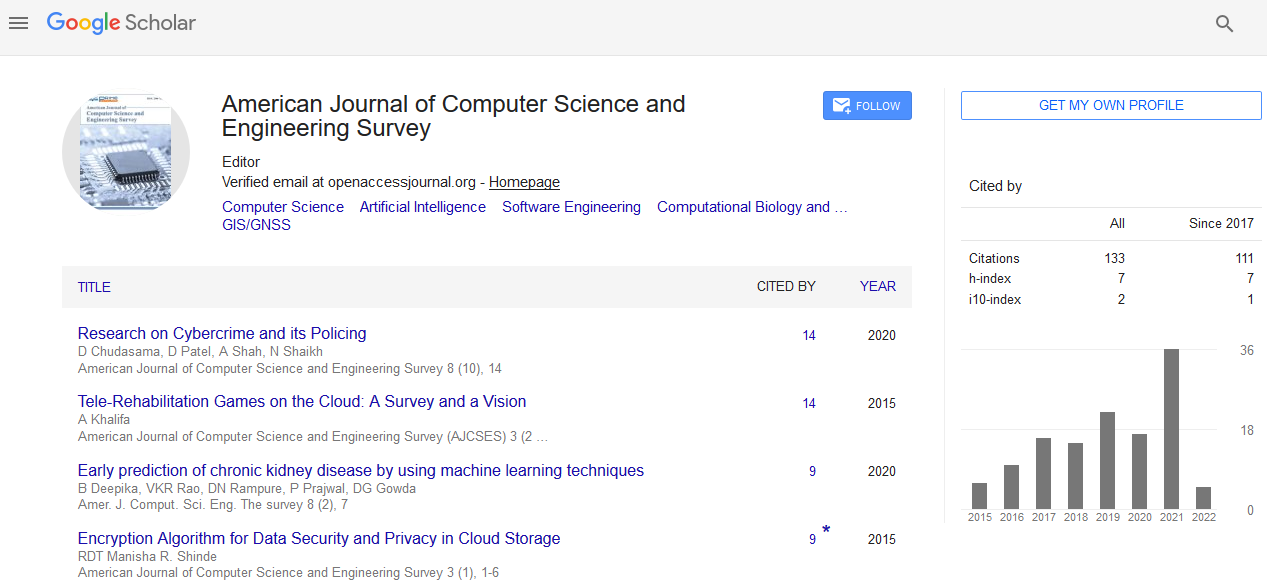Short Communication - (2024) Volume 12, Issue 4
Cybersecurity: Protecting the Digital World
Ashika Singh*
Department of Cyber Security, Lovely Professionsal University, India
*Correspondence:
Ashika Singh,
Department of Cyber Security, Lovely Professionsal University,
India,
Email:
Received: 02-Dec-2024, Manuscript No. IPACSES-25-22464;
Editor assigned: 04-Dec-2024, Pre QC No. IPACSES-25-22464 (PQ);
Reviewed: 18-Dec-2024, QC No. IPACSES-25-22464;
Revised: 23-Dec-2024, Manuscript No. IPACSES-25-22464 (R);
Published:
30-Dec-2024, DOI: 10.36846/2349-7238.24.12.31
Introduction
In todayâ??s interconnected world, where nearly everything is
linked to the internet, cybersecurity has become a top priority.
As more personal, financial, and sensitive data is stored online,
the risk of cyberattacks, data breaches, and identity theft has
escalated. Cybersecurity refers to the practice of protecting
systems, networks, and data from digital threats, ensuring that
information remains safe from unauthorized access, attacks,
and damage. The growing prevalence of cyberattacks underscores
the importance of strong cybersecurity practices.
Description
This article explores the basics of cybersecurity, the types of cyber
threats, and strategies to safeguard our digital lives. Cybersecurity
encompasses a wide range of practices, technologies,
and policies designed to protect computers, networks, programs,
and data from cyber threats. These threats can come
from various sources, including hackers, malware, and cybercriminal
organizations, and can target individuals, businesses,
governments, and other institutions. As digital services and online
transactions have become more integral to everyday life,
cybersecurity is no longer just an IT concern; itâ??s a fundamental
issue for everyone who uses technology. The consequences of
poor cybersecurity can be catastrophic: Cyberattacks like ransomware
or data breaches can result in significant financial
losses for individuals and businesses. Personal information,
including social security numbers, credit card data, and medical
records, can be stolen and used for fraudulent activities.
For businesses, a security breach can damage reputation and
erode trust, resulting in lost customers and legal ramifications.
Governments and critical infrastructures are prime targets for
cyberattacks, which can lead to disruptions in services and
even threats to national security. Protecting yourself or your
organization from cyber threats requires a proactive approach
to cybersecurity. Below are some key strategies for building
strong defenses: Strong, unique passwords are one of the most
basic yet important defenses against cyberattacks. Passwords
should be complex, combining letters, numbers, and special
characters. Using a password manager can help you maintain
and generate secure passwords. MFA adds an extra layer of
security by requiring users to provide two or more forms of
identification before accessing an account. This could include a
password, a text message code, or biometric recognition (like
a fingerprint). Regularly updating operating systems, applications,
and antivirus software is critical for patching vulnerabilities
that could be exploited by cybercriminals. Many software
updates include fixes for known security flaws. Firewalls help
protect your network by blocking unauthorized access, while
antivirus software detects and removes malware. Both are essential
tools for defending against a variety of cyber threats.
Cybersecurity is not just about technology but also about people.
Employees and individuals should be trained to recognize
phishing emails, use strong passwords, and follow security best
practices. Regularly backing up important files ensures that, in
the event of a ransomware attack or data loss, you can restore
your data with minimal disruption. Use encryption, VPNs (Virtual
Private Networks), and secure Wi-Fi settings to protect
your personal and business networks from unauthorized access.
Avoid using public Wi-Fi for sensitive transactions when
possible. As technology continues to evolve, so do the threats
that cybersecurity seeks to defend against. [1-4].
Conclusion
The rise of the Internet of Things (IoT), 5G networks, and
AI-driven cyberattacks will require new approaches to security.
Innovations like machine learning and artificial intelligence are
already being used to detect anomalies in real time and predict
potential security breaches before they occur. Cybersecurity
will also need to become more integrated into everyday technology,
with better tools to protect consumers in an increasingly
connected world. However, as threats grow in sophistication,
itâ??s essential for both individuals and organizations to remain
vigilant and adaptable in the fight to secure their digital assets.
Acknowledgement
None.
Conflicts Of Interest
None.
References
- Pastena L (2014) Catenary-free electrification for urban transport: An overview of the tramwave system. IEEE Electrif Mag. 2(3): 16-21.
[Crossref] [Google Scholar]
- Li S, Mi C (2015) Wireless power transfer for electric vehicle applications. J Emerg Sel Top Power Electron. 3(1): 4-17.
[Crossref] [Google Scholar]
- Jang Y (2018) Survey of the operation and system study on wireless charging electric vehicle systems. Transp Res Part Emerg Technol. 95: 844-866.
[Crossref] [Google Scholar]
- Seriani S, Gallina P, Wedler A (2017) Dynamics of a tethered rover on rough terrain. Mech Mach Sci. 47: 355-361.
[Crossref] [Google Scholar]
Citation: Singh A (2024) Cybersecurity: Protecting the Digital World. Am J Comp Science. 12:31.
Copyright: © 2024 Singh A. This is an open-access article distributed under the terms of the Creative Commons Attribution License,
which permits unrestricted use, distribution and reproduction in any medium, provided the original author and source
are credited.

